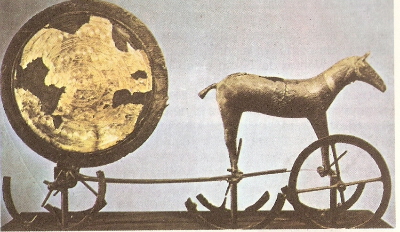
The Age of Metals |
Name: ______________________________________ Subject: _______________________ Date: _______
Write on the right side what is missing.

1. The Age of Metals
When humans gradually discovered metals, they gradually abandoned stone as the basic element for their instrument and tools. Three stages are distinguished within this Age due to the different types of metals that were used:
- Copper was the first known metal. It is of a low hardness and it was used to make ornaments.
- Bronze is an alloy of copper and tin and it is harder and stronger than copper. Several eastern Mediterranean peoples discovered this metallurgy and progressed rapidly.
During this Age, agricultural tools were developed with bronze, such as plows and sickles, military weapons like swords, spears and shields, as well as household utensils like jars, bowls and cups. On the image above, there is a cart (offering to the Sun God), which was found in Trundholm (Denmark) and was made our of bronze and gold.
This metal was discovered in the year 3000 A.C.
- Iron was found somewhere near the Black Sea.
It is harder and more durable than bronze, and was served as a main element in the manufacturing of objects.
The first instruments were manufactured at around 1,200 A.C.
This metal was then spread by the Celts to the peoples of the Mediterranean.
A) Indicate to what stage the following statements refer to (copper, bronze, or iron)
It was discovered around the Black Sea |
|
It has low hardness |
|
It is an alloy of copper and tin |
|
It is harder than bronze |
|
It was used to make adornments |
|
It was discovered towards the year 3,000 A.C. |
|
It was discovered at around 1,200 A.C. |
|
|
|
2. The Megalithic Monuments
The religiosity of prehistoric humans is evident on what are called megalithic monuments (mega = big, and lithic = stone). They were called as such because they were made of big stones.
These monuments represent the very first architectural manifestation of history, and would take up different forms. They can be classified in the following groups:
- Menhir, which is a large stone that stands vertically on the ground.
- Alignments, which are menhirs placed in a straight line.
- Cromlechs, which are menhirs arranged in circles.
- Horizontal Dolmens, which are large horizontal stones placed on other stones vertically in the form of a table. (Please look at the top left image displaying the dolmen Mans Salas, Muiño, Ourense, Spain).
- Naveta, which are shaped like an inverted boat. It would serve the purpose of funerals. (Please look at the top right image displaying the naveta des Tudons, Menorca, Spain).
B) Indicate whether the following monuments are menhirs, alignments, cromlechs, dolmens, or naveta
It is shaped like a table |
|
It is a stone that vertically stands on the ground |
|
It is composed of various menhirs in a row |
|
They are menhirs in circles |
|
It is like an inverted boat |
| Educational applications | History | In Spanish | Interactive |
®Arturo Ramo García.-Record of intellectual property of Teruel (Spain)
No 141, of 29-IX-1999
Plaza Playa de Aro, 3, 1º DO 44002-TERUEL